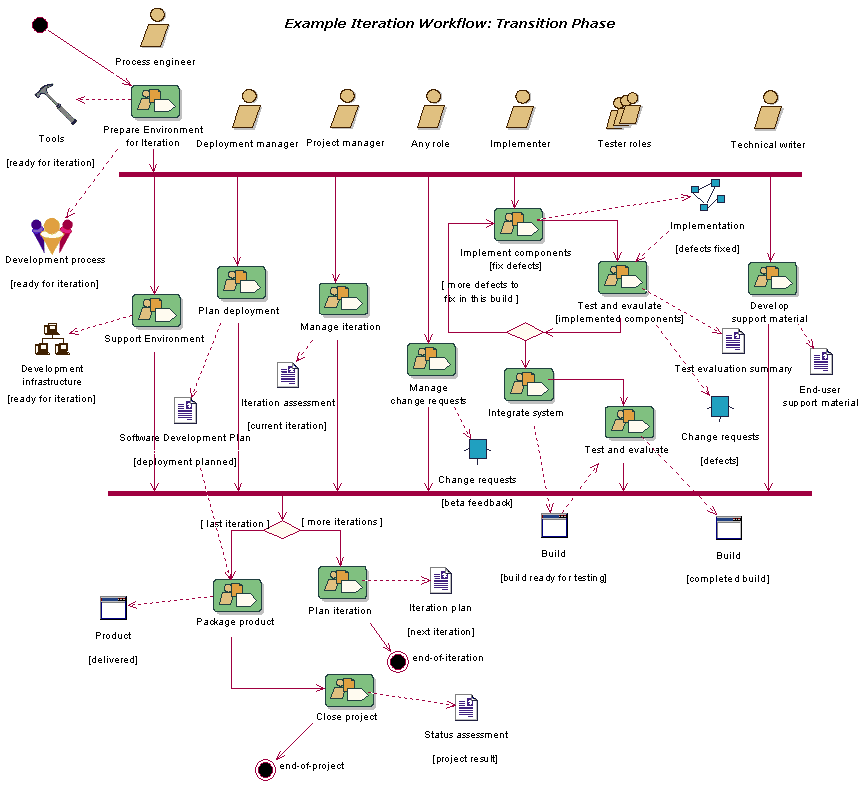Phase: Transition
|
The focus of the Transition Phase is to ensure that software is available for its end users. The Transition Phase can span several iterations, and includes testing the product in preparation for release, and making minor adjustments based on user feedback. At this point in the lifecycle, user feedback should focus mainly on fine tuning the product, configuring, installing and usability issues, all the major structural issues should have been worked out much earlier in the project lifecycle. |
|
|
Workflow details typically performed in an iteration in Transition for medium sized projects. |
Objectives 
By the end of the Transition Phase lifecycle objectives should have been met and the project should be in a position to be closed out. In some cases, the end of the current life cycle may coincide with the start of another lifecycle on the same product, leading to the next generation or version of the product. For other projects, the end of Transition may coincide with a complete delivery of the artifacts to a third party who may be responsible for operations, maintenance and enhancements of the delivered system.
This Transition Phase ranges from being very straightforward to extremely complex, depending on the kind of product. A new release of an existing desktop product may be very simple, whereas the replacement of a nation's air-traffic control system may be exceedingly complex.
Activities performed during an iteration in the Transition Phase depend on the goal. For example, when fixing bugs, implementation and test are usually enough. If, however, new features have to be added, the iteration is similar to one in the construction phase requiring analysis & design, etc.
The Transition Phase is entered when a baseline is mature enough to be deployed in the end-user domain. This typically requires that some usable subset of the system has been completed with acceptable quality level and user documentation so that transitioning to the user provides positive results for all parties.
The primary objectives of the Transition phase include:
- beta testing to validate the new system against user expectations
- beta testing and parallel operation relative to a legacy system that it's replacing
- converting operational databases
- training of users and maintainers
- roll-out to the marketing, distribution and sales forces
- deployment-specific engineering such as cutover, commercial packaging and production, sales roll-out, field personnel training
- tuning activities such as bug fixing, enhancement for performance and usability
- assessment of the deployment baselines against the complete vision and the acceptance criteria for the product
- achieving user self-supportability
- achieving stakeholder concurrence that deployment baselines are complete
- achieving stakeholder concurrence that deployment baselines are consistent with the evaluation criteria of the vision
Essential Activities 
The essential activities of the Transition phase include:
- executing deployment plans
- finalizing end-user support material
- testing the deliverable product at the development site
- creating a product release
- getting user feedback
- fine-tuning the product based on feedback
- making the product available to end users
Milestone 
The Product Release Milestone is where you decide if the objectives of the project were met, and if you should start another development cycle. See Milestone: Product Release for details.
Tailoring Decisions 
The example iteration workflow shown at the top of this page represents a typical Transition iteration in medium sized projects. The Sample Iteration Plan: Transition Phase represents a different perspective of the breakdown of activities to undertake in an Transition iteration. This iteration plan is more complete in terms of workflow details and activities, and as such, more suitable for larger projects. Smaller projects might decide to do only a subset of these workflow details, deviations should be challenged and documented as part of the project-specific process. When planning an iteration in Transition, keep in mind that the project's focus may shift from beginning of the phase to the end, and the iteration workflows may differ slightly from one iteration to the other. For example - in the Transition phase - a project will focus more on defect fixes in the first iteration, and more on activities related to closing the project in the last iteration.

